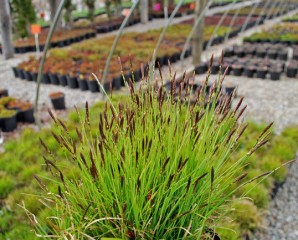Mt. Cuba Center is a non-profit botanical garden located in Hockessin Delaware. Originally a private garden, the transition to a public garden began in 2002, also the first year in which native plant trials were started. Over the years, many native plants have been tested, with Carex being the most genus to be reviewed. 70 different types of Carex were evaluated, and we have a number of the highest ranking species at Planters’ Choice.
No surprise, Carex pensylvanica, Pennsylvania Sedge (pictured), is one of the top performers. It performs well in both sun and shade, forming a green carpet that acts as living mulch among taller perennials, helping to cover the ground and suppress weeds. It is one of the best plants for dry shade. Maximum height is a little over one foot, while a single plant will spread to cover an area four feet in diameter in about four years. For those looking for a lawn replacement, the Mt. Cuba trials included mowing! Carex pensylvanica performed well in a season-long mowing test, with bi-weekly trims to a height of four inches. The plants in this trial did not receive any supplemental water or fertilization and maintained their green and lush appearance. Looks like a good alternative for a traditional lawn for shade.
Another top performer is Carex plantaginea, Plantain Leaf Sedge. A star performer in shade, it did not do well in sun. The foliage is broad and heavily textured, and nearly evergreen. The tips may dry out by the end of winter, so a site protected from winter sun is recommended. The foliage grows slowly, so should not be cut back hard at the end of winter. It blooms early, with dark, spear-like flowering stems emerging during March. The flowers work well with spring ephemerals in a woodland garden, as the plants prefer the same rich, moist soil. This variety is not a mowed lawn alternative. In addition to not thriving in sun, the slow growth rate of the leaves and clumping habit do not look good after a mowing. Plant height is one foot, and clumps grow to two feet wide.
There is a sedge for every environment in the garden, even the waterlogged spots. Carex stricta, Tussock Sedge, performs best in full sun, while doing well in shade. It can be found as tiny hummocks in standing water, and is also able to withstand short periods of drought. This sedge is deciduous, sending up silvery slivers of new growth in the spring. Flowers emerge shortly after, with inflorescences of white and brown. The leaves are deep green throughout the growing season. No surprise, this variety did not do well in the mowing trial. Also of note, it is used by the endangered bog turtle as a nesting site. It is well-suited for wet, open meadows and rain gardens.
A strong performer for both sun and shade, Carex amphibola, Eastern narrow-leaved sedge, is best suited for average to wet soils. This species forms a fountain-shaped mound of shiny, dark green foliage. Green scaly flowers spikes bloom in late spring, and the resulting seeds are eaten by turtles. The foliage droops a bit after flowering, but will revive with new growth shortly after. Mature size is 17” tall, and 32” wide. C. amphibola is deer (and other herbivore) resistant, but not drought resistant. This variety did okay in the mowing trial, so is a possible lawn substitute in a shady, moist area.
Carex appalachica, Appalachian Sedge, resembles Carex pensylvanica in foliage and overall dimensions, though is clump forming rather than spreading, and needs drier conditions. Foliage is a rich, green color, narrow and about one foot long. It does not do well in overly moist soil, so be sure to site in a well-drained area. It prefers a well-drained slope, and is well-behaved when interplanted with other woodland plants. It will spread to form a colony, so can be used as a ground cover for soil stabilization and erosion control. Flowers bloom in May, and are inconspicuous, but provide nectar to insects and seed to birds and turtles.

